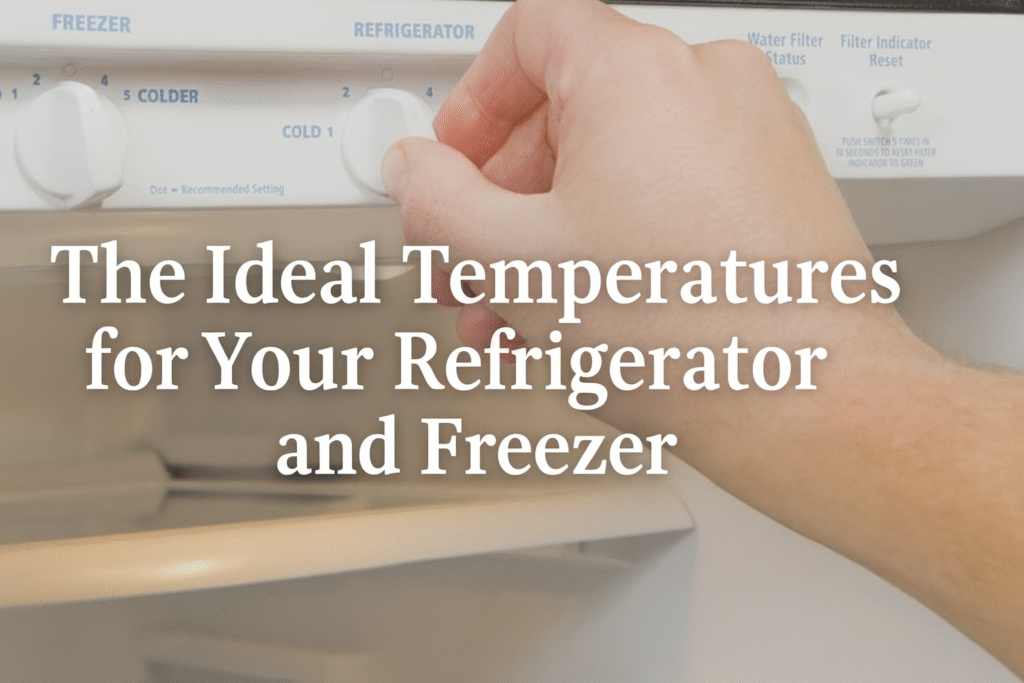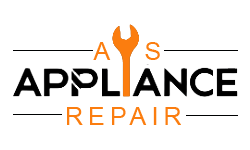
One of the simplest methods of preserving your food, saving money on energy, and ensuring that your appliance works well is keeping your refrigerator and freezer at the appropriate temperature. By determining the perfect setting in your fridge and freezer, you avoid bacteria development, spoilage of food, and extend the life of your appliance. AS Appliance Repair is among the companies that will help you with the professional advice about the correct settings, their importance, and the maintenance to sustain the best performance at all levels and make sure your fridge and freezer perform efficiently on a daily basis.
Why the Right Refrigerator and Freezer Temperatures are Important.
It is important to maintain the right refrigerator and freezer temperatures to ensure the safety and freshness of food and long life of your appliance. By making sure that your fridge is kept at the proper refrigerator temperature, you extend the shelf life of your food and turn down the likelihood of the range of dangerous bacteria developing. When it is too hot, the goods become spoiled in a short time. In case of extreme cold, food such as fruits, vegetables, and beverages can freeze or be deprived of their texture.
It is also important to keep the temperature of your refrigerator within the right range so that your appliance can perform more effectively. Consistency in temperature implies minimal pressure on the cooling mechanism, which can assist you to prevent any unnecessary refrigerator repair in future. This is also applicable to your freezer, regular cooling keeps food frozen and of good quality. By adhering to the recommended ideal temperatures, this is a way of preserving your food and your appliance as well.
What Is the Ideal Temperature for a Refrigerator?
The ideal refrigeration temperature is necessary to preserve your food in a safe and fresh state. Experts suggest that you place your fridge with a temperature of 35°F to 38°F (1.6°C–3.3°C). This range is not too cold or too hot to preserve your groceries and not too cold to freeze your food. Most individuals believe that 37degF (2.7degC) is the optimal in the normal fridge temperature since it is the temperature that balances optimally.
This is one of the recommended temperatures for refrigerator to be set at to preserve quality and taste. When your fridge is turned too hot, products can spoil easily. When it is too cold, vegetables and drinks may freeze. The temperature in your refrigerator should be set to this proposed level, and this is the easiest way to ensure that your food is safe, fresh and it is ready to be eaten every day.
The Recommended Refrigerator Temperature Range.
The regular refrigerator temperature between 35°F and 38°F is advantageous to the majority of households. This is an ideal range to use on a daily basis and suits a regular-size refrigerator. This is the fridge range to maintain quality and freshness. When the temperatures are too low you may find that your food is being frozen or ice is building up on shelves. When the temperatures are high, food spoils easily and it might be unsafe to consume.
Refrigerator temperature also helps in maintaining airflow by keeping the temp normal. Existence of good airflow also makes sure that all shelves and compartments are kept cool evenly. Checking your temperature and making minor changes by periodically monitoring your freezer temperature guarantee safety in storage and minimize chances of future refrigerator repair.
Indications that Your Refrigerator Temperature is Incorrect.
At a temperature other than the usual refrigerator temperature, you will soon see evidence of it. Bad smells, soft cheese, and spoiled milk are major indications that the refrigerator is excessively warm. When your fridge is refrigerated excessively, frozen salads, frozen frozen fruit, and frozen beverages are the obvious symptoms that you have the refrigerator on too low. Such symptoms tend to indicate that the optimal temperature of the refrigerator is disturbed.
The wrong temperatures also cause your appliance to work harder than it is supposed to work. It may result in an increase in the cost of energy and can cause a rise in future refrigerator repair expenses. It is possible to check your settings or be aware of the texture and freshness of your food so that you could correct the situation before it becomes more complex.
What Should Be the Ideal Temperature of Your Freezer?
Your freezer just like your refrigerator also requires a constant and accurate temperature to operate sufficiently. The optimal refrigerator temperature to store food is important, however, your freezer is even more strict. The optimal freezer temperature is 0F -18 C. Bacteria at this level do not grow and your food remains frozen and safe over extended periods of time.
A low temperature of the freezer also preserves the texture and taste. When the temperature changes at opposite ends, even a minor increase, things can begin to thaw and refreeze and this can influence quality. When it becomes too cold, the frost may form. The temperature monitoring can assist in preventing issues that can lead to the necessity of freezer repairing. A properly installed freezer will ensure your frozen foods are in an ideal condition.
When Your Freezer Temperature Is Incorrect.
It is easy to notice when your freezer is not at the appropriate temperature. An indicator of temperature problems is soft ice cream, partially thawing meat, or frost formation. When your freezer becomes warmer than 0°F (–18°C) then the food will start to soften or have ice crystals. When it is very cold you can have heavy frost and this decreases airflow and cooling efficiency.
The wrong temperature can also put strain on the parts of the freezer, and this will most likely make you have to repair the freezer. It is a good idea to check your settings regularly, and to make sure that there is no food that would block the vents to achieve a consistent cooling. The most convenient way to make sure your food remains safe and frozen is to maintain your freezer at the optimum temperature.
How to Check the Temperature Accurately.
Most individuals use the in-built dial available on the inside of their fridge or freezer, which is not always accurate. An independent thermometer should be used to determine your refrigerated temp. The best reading is the one obtained by putting it in the middle of your fridge or freezer. The inbuilt indicators can only indicate approximate levels, which do not necessarily reflect actual temperature of the refrigerator inside.
Monitor the temperature every one or two weeks to ensure that it does not exceed the optimal range. Should you make alterations to your settings, then wait at least 24 hours and then recheck again. This is used to stabilize the appliance to avoid false reading. A basic thermometer will assist you in keeping things safe and preventing future malfunctions of the appliances.
Ways to ensure the right refrigerator temperature.
A few simple habits can help maintain the normal temp in the refrigerator settings. Always keep the refrigerator door shut as much as possible to avoid the entry of warm air. Do not over-pack the fridge because the tight shelves may stop airflow. Nevertheless, do not fill it completely either, a moderate fullness is good to keep the temperature steady.
Allow hot food to be cooled down and then put it in the fridge. Putting warm food in it may temporarily increase the refrigerator temperature and impact other products. Make sure that the door seals are closed well by placing a piece of paper in the door, when it moves out easily, then the seal might be loose. It is also important to clean your condenser coils after every few months to ensure you maintain efficiency and save future refrigeration repair.
Factors which influence the temperature of a refrigerator and freezer.
A number of aspects may influence the performance of your fridge and freezer. The temperature of the room is also significant, when your kitchen is hot, then your appliance will work harder to keep the temperature down. Excessive opening of the fridge door also allows cold air to escape, which leads to the optimal temperature of the refrigerator getting out of range. Crowding your shelves may obstruct vents and limit air flow resulting in warm areas indoors.
Refrigerated temp can also be impacted during power outages and food spoilage may occur without attention. Bad spacing or blocked vents within the freezer can result in uneven freezing and can lead to the probability of having freezer repair. Knowing these will assist you to keep your temperatures constant and preserve your food.
Common Temperature Problems and How to Fix Them.
Simple solutions can be used when temperature problems occur before it is time to call in refrigerator repair or freezer repair. In case food freezes in your refrigerator, it is better to raise the temperature inside the fridge a bit and ensure that the products are not packed against the wall. When your fridge is not cooling well, clean the coils, check door seals and make sure that it has sufficient space around it to ventilate.
In a warm freezer, ensure that it has a temperature set at 0°F (–18°C) and the door should close well. In case there is a frost formation, ensure the vents are not blocked. When the problems still persist after the adjustments, then perhaps it is time to invite a professional technician, e.g. AS Appliance Repair to identify more serious cooling problems.
How to Survive in the Event of a Power Outage.
The most significant thing to do in the case of a power outage is to have your fridge and freezer doors closed. A fridge with closed doors is capable of maintaining the cool of food within four hours, and a full freezer can last up to 48 hours. When power goes back, use a thermometer to test the refrigerated temperature to be sure that food is not spoiled.
When the temperature exceeds safe levels too long, there are certain things that might have to be discarded. Do not taste the food to determine whether it is safe, appearance and smell is deceptive. Having a stock of food helps to preserve it so that it is not spoilt easily or makes you sick because of a power outage.
Final Thoughts.
The easiest way to keep your food safe, fresh and prolonged is to set the optimal refrigerator temperature and keep the freezer at 0°F. Taking temperature checkings, cleaning coils and appropriate storage behaviors are all helpful in making your appliance run properly. Problems can be avoided at small stages when they arise.
And when your fridge or freezer still fails to keep the temperature under control, it might be time to call in the help of the professional. AS Appliance Repair will provide you with excellent refrigerator repair and freezer repair services in Toronto making sure that your refrigerator cools as it is supposed to. Maintaining the health of your appliances is keeping your food healthy in the process of your daily routine.
Make your refrigerator and your freezer run at an optimum temperature! Contact AS Appliance Repair now and get fast, reliable and professional fridge and freezer repair services in Toronto.

